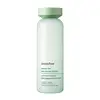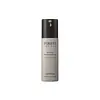What's inside
What's inside
 Key Ingredients
Key Ingredients

 Benefits
Benefits

 Concerns
Concerns

No concerns
 Ingredients Side-by-side
Ingredients Side-by-side

Water
Skin ConditioningPropanediol
SolventButylene Glycol
HumectantGlycerin
HumectantHydrogenated Polyisobutene
Emollient1,2-Hexanediol
Skin ConditioningBetaine
HumectantNiacinamide
SmoothingBehenyl Alcohol
EmollientAmmonium Acryloyldimethyltaurate/Vp Copolymer
Glyceryl Caprylate
EmollientTromethamine
BufferingCarbomer
Emulsion StabilisingAcrylates/C10-30 Alkyl Acrylate Crosspolymer
Emulsion StabilisingEthylhexylglycerin
Skin ConditioningDisodium EDTA
Camellia Sinensis Leaf Extract
AntimicrobialArginine
MaskingAspartic Acid
MaskingGlutamic Acid
HumectantHyaluronic Acid
HumectantZinc PCA
HumectantGluconolactone
Skin ConditioningTocopherol
AntioxidantWater, Propanediol, Butylene Glycol, Glycerin, Hydrogenated Polyisobutene, 1,2-Hexanediol, Betaine, Niacinamide, Behenyl Alcohol, Ammonium Acryloyldimethyltaurate/Vp Copolymer, Glyceryl Caprylate, Tromethamine, Carbomer, Acrylates/C10-30 Alkyl Acrylate Crosspolymer, Ethylhexylglycerin, Disodium EDTA, Camellia Sinensis Leaf Extract, Arginine, Aspartic Acid, Glutamic Acid, Hyaluronic Acid, Zinc PCA, Gluconolactone, Tocopherol
Water
Skin ConditioningPropanediol
SolventDimethicone
EmollientGlycereth-26
Humectant1,2-Hexanediol
Skin ConditioningBis-PEG-18 Methyl Ether Dimethyl Silane
EmollientMannitol
HumectantMethyl Trimethicone
Skin ConditioningButylene Glycol
HumectantPPG-13-Decyltetradeceth-24
EmulsifyingHydroxyethyl Acrylate/Sodium Acryloyldimethyl Taurate Copolymer
Emulsion StabilisingPolysorbate 20
EmulsifyingCetearyl Alcohol
EmollientAcrylates/C10-30 Alkyl Acrylate Crosspolymer
Emulsion StabilisingParfum
MaskingTromethamine
BufferingGlyceryl Caprylate
EmollientGlyceryl Stearate
EmollientEthylhexylglycerin
Skin ConditioningStearic Acid
CleansingHydrogenated Lecithin
EmulsifyingPhenoxyethanol
PreservativeBiosaccharide Gum-1
HumectantDisodium EDTA
Polyglyceryl-3 Methylglucose Distearate
EmulsifyingSorbitan Isostearate
EmulsifyingGlycoproteins
Skin ConditioningAureobasidium Pullulans Ferment
Skin ConditioningBHT
AntioxidantPotassium Hydroxide
BufferingAcetic Acid
BufferingTocopherol
AntioxidantWater, Propanediol, Dimethicone, Glycereth-26, 1,2-Hexanediol, Bis-PEG-18 Methyl Ether Dimethyl Silane, Mannitol, Methyl Trimethicone, Butylene Glycol, PPG-13-Decyltetradeceth-24, Hydroxyethyl Acrylate/Sodium Acryloyldimethyl Taurate Copolymer, Polysorbate 20, Cetearyl Alcohol, Acrylates/C10-30 Alkyl Acrylate Crosspolymer, Parfum, Tromethamine, Glyceryl Caprylate, Glyceryl Stearate, Ethylhexylglycerin, Stearic Acid, Hydrogenated Lecithin, Phenoxyethanol, Biosaccharide Gum-1, Disodium EDTA, Polyglyceryl-3 Methylglucose Distearate, Sorbitan Isostearate, Glycoproteins, Aureobasidium Pullulans Ferment, BHT, Potassium Hydroxide, Acetic Acid, Tocopherol
 Reviews
Reviews

Ingredients Explained
These ingredients are found in both products.
Ingredients higher up in an ingredient list are typically present in a larger amount.
1,2-Hexanediol is a synthetic liquid and another multi-functional powerhouse.
It is a:
- Humectant, drawing moisture into the skin
- Emollient, helping to soften skin
- Solvent, dispersing and stabilizing formulas
- Preservative booster, enhancing the antimicrobial activity of other preservatives
Acrylates/C10-30 Alkyl Acrylate Crosspolymer is a synthetic polymer. It is used to thicken and improve the texture of products. Due to its properties, it can prevent water and oil ingredients from separating.
Butylene Glycol (or BG) is used within cosmetic products for a few different reasons:
Overall, Butylene Glycol is a safe and well-rounded ingredient that works well with other ingredients.
Though this ingredient works well with most skin types, some people with sensitive skin may experience a reaction such as allergic rashes, closed comedones, or itchiness.
Learn more about Butylene GlycolDisodium EDTA plays a role in making products more stable by aiding other preservatives.
It is a chelating agent, meaning it neutralizes metal ions that may be found in a product.
Disodium EDTA is a salt of edetic acid and is found to be safe in cosmetic ingredients.
Learn more about Disodium EDTAEthylhexylglycerin (we can't pronounce this either) is commonly used as a preservative and skin softener. It is derived from glyceryl.
You might see Ethylhexylglycerin often paired with other preservatives such as phenoxyethanol. Ethylhexylglycerin has been found to increase the effectiveness of these other preservatives.
Glyceryl Caprylate comes from glycerin and caprylic acid, a fatty acid from coconut. It has emollient and emulsifier properties.
As an emollient, it helps hydrate your skin. Emollients work by creating a barrier on your skin to trap moisture in, helping to keep your skin soft and smooth.
On the other hand, emulsifiers prevent ingredients (such as oil and water) from separating.
Learn more about Glyceryl CaprylatePropanediol is an all-star ingredient. It softens, hydrates, and smooths the skin.
It’s often used to:
Propanediol is not likely to cause sensitivity and considered safe to use. It is derived from corn or petroleum with a clear color and no scent.
Learn more about PropanediolTocopherol (also known as Vitamin E) is a common antioxidant used to help protect the skin from free-radicals and strengthen the skin barrier. It's also fat soluble - this means our skin is great at absorbing it.
Vitamin E also helps keep your natural skin lipids healthy. Your lipid skin barrier naturally consists of lipids, ceramides, and fatty acids. Vitamin E offers extra protection for your skin’s lipid barrier, keeping your skin healthy and nourished.
Another benefit is a bit of UV protection. Vitamin E helps reduce the damage caused by UVB rays. (It should not replace your sunscreen). Combining it with Vitamin C can decrease sunburned cells and hyperpigmentation after UV exposure.
You might have noticed Vitamin E + C often paired together. This is because it is great at stabilizing Vitamin C. Using the two together helps increase the effectiveness of both ingredients.
There are often claims that Vitamin E can reduce/prevent scarring, but these claims haven't been confirmed by scientific research.
Learn more about TocopherolTromethamine helps balance the pH and improve the texture of a product. It is synthetically created.
As an emulsifier, Tromethamine prevents oil and water ingredients from separating. This helps stabilize the product and elongate a product's shelf life. Tromethamine also makes a product thicker.
Tromethamine helps balance the pH level of a product. Normal pH level of skin is slightly acidic (~4.75-5.5). The acidity of our skin is maintained by our glands and skin biome. Being slightly acidic allows our skin to create an "acid mantle". This acid mantle is a thin barrier that protects our skin from bacteria and contaminants.
Oral Tromethanmine is an anti-inflammatory drug but plays the role of masking, adding fragrance, and/or balancing pH in skincare.
1,3-Propanediol, 2-amino-2-(hydroxymethyl)-
Learn more about TromethamineWater. It's the most common cosmetic ingredient of all. You'll usually see it at the top of ingredient lists, meaning that it makes up the largest part of the product.
So why is it so popular? Water most often acts as a solvent - this means that it helps dissolve other ingredients into the formulation.
You'll also recognize water as that liquid we all need to stay alive. If you see this, drink a glass of water. Stay hydrated!
Learn more about Water